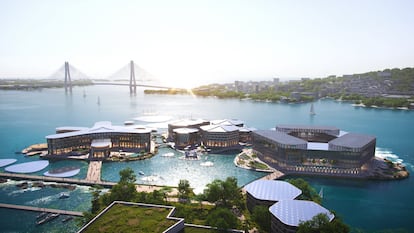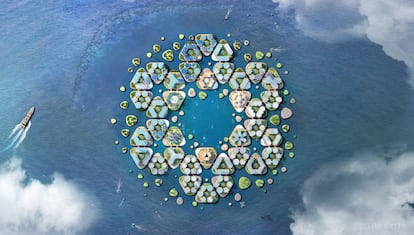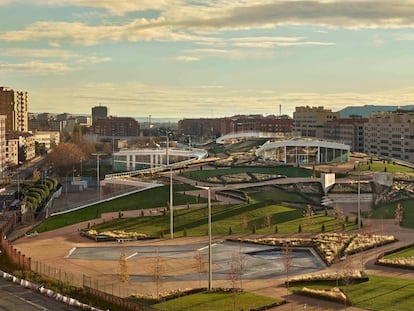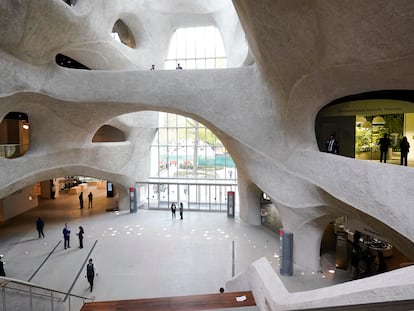Oceanix Busan: The dream of building a floating city to tackle climate change
South Korea plans to monitor the energy consumed and waste generated by 300 inhabitants in a city that adapts to the sea level


A dairy farm, a park made up of islands and a luxury hotel that rotates on the water to generate electricity. These are some of the floating architecture projects that have made headlines in recent years. Now, much of the attention is focused on Oceanix Busan, a prototype of a floating city that adapts to sea level to house climate refugees. The goal is for this city to be ready before 2030, the year in which Busan aspires to host World Expo 2030.
Busan is South Korea’s largest port city. Hwang Hyun-ki, spokesman for the division in charge of the metropolitan city’s overseas exhibition outreach, welcomes a group of Spanish journalists in a building in the North Harbor. “That’s where the floating city will be built,” he says proudly from a terrace while pointing a pointer to the water.
The goal is for Oceanix Busan to adapt to sea level, which has risen more than 20 centimeters (more than seven inches) since 1880, according to the U.S. National Office of Oceanic and Atmospheric Administration. Two out of every five people in the world live within 100 kilometers (62 miles) of the coast and 90% of megacities are vulnerable to sea level rise, according to the United Nations Human Settlements Programme (UN-Habitat). A study published in the scientific journal Nature Communications indicates that between 1993 and 2015, the risk of coastal flooding increased by almost 50% on a global scale. The future does not look optimistic: from 2050 onwards, coastal areas where 300 million people now live could be flooded every year.

Oceanix Busan will study which technologies could be extrapolated to other land-scarce coastal cities. In theory, this floating laboratory will occupy an area of 60,000 square meters and will have three hexagonal modules. Of the 900 people who will be able to live in them, 300 will be part of a pilot project in which data will be collected to test whether the city is livable and sustainable. For example, they will measure how much energy they consume, how much waste they generate and whether it is 100% recyclable, says Hyun-ki: “We will test whether the place is self-sufficient.” Its creators claim that, in that case, this city could be transformed to house 10,000 people.
The site chosen to build this city is perfect, according to Daniel Sundlin, a partner at Bjarke Ingels Group (BIG): “It is close to the city, but has relatively deep water.” This architectural firm is in charge of designing the prototype together with Samoo — from the Samsung Group — and Oceanix, a company specializing in floating structures based in New York. The project will be carried out with UN-Habitat.
Lots of promises to keep
The three floating platforms will be connected to land with bridges. Biorock, a material that can be beneficial for the restoration of coral reefs and marine ecosystems, will be used to construct their underside. “The platforms provide regenerative living surfaces creating habitats that filter and clean polluted port water,” Oceanix says on its website.
On paper it all sounds promising: energy from renewable sources, electric vehicles, plant-based urban agriculture and water filtration and harvesting systems. In addition to housing, there will supposedly be dedicated research areas, supermarkets and “intimate alleyways filled with local food vendors, crafts and bookstores.” The company envisions a dream place: “A home for residents and an incredible destination for visitors who embrace a sustainable lifestyle.”

EL PAÍS has contacted Oceanix to request more details about the project, but so far no response has been obtained. Many details about this floating city are still unknown, such as the technical aspects of the project, the real cost or if there is any plan to avoid damaging the marine ecosystem. Hyun-Ki explains that the project is in a planning stage that will last until the end of the year. They are assessing how to build the structures — what will be the roadmap to obtain the necessary permits from the authorities and the economic feasibility. The estimated budget, he says, is $600 million.
Oceanix Busan is scheduled to be built between 2025 and 2028. Busan is one of the candidate cities to host Expo 2030, which is why EL PAÍS has been invited to visit this city by Samsung. The South Korean company represents 20% of the country’s GDP and plans to take advantage of this event to present some of its technologies. Busan competes with Rome (Italy), Riyadh (Saudi Arabia) and Odessa (Ukraine). If it is chosen, South Korea plans to invest $5.73 billionto build Oceanix Busan, remodel the North Port and undertake other works.
Artificial islands in New York and futuristic cities
Floating cities such as Oceanix Busan have been in the collective imagination for decades. Several initiatives aspire to extend New York into the sea with artificial, self-sufficient floating islands. Those most critical of these projects question precisely the lack of details for them to come to fruition. Hyun-ki compares the Busan project to NEOM City in Saudi Arabia, which is supposed to house a futuristic city on water called Oxagon. The only difference, he explains, is that Oceanix Busan is being realized through an agreement with the UN for people who used to live in coastal areas and have had to relocate.
But to what extent is it feasible to build floating cities? Brydon T. Wang, a lawyer with a background in architecture and a construction law researcher at Queensland University of Technology, explains that it depends on how you define the term floating city and where you place it. “If you’re just talking about structures that float semi-permanently or permanently on the water, we already have the technology, engineering skills and manufacturing capabilities to build structures that will last more than 50 years,” says Wang, who is co-editor of the book Great Floating Structures.
Where these cities are based is important. Some like Oceanix Busan “must be in calm, protected waters close to land, in the water space adjacent to a country.” “If you put this floating city in the middle of international waters, it won’t look like Oceanix Busan, sitting on pontoons,” the expert emphasizes. In that case, “it will look more like a city sitting on semi-submersible structures, like oil rigs sitting on water.”
For now, Wang does not consider it feasible to build a floating city in international waters. “When you create artificial land in the middle of the ocean, you have complex interactions between land-based legal frameworks and international maritime law,” he says. On top of that, you have to deal with the social development of the cities: “Cities that are built from scratch don’t tend to be vibrant, socially and culturally successful cities.” Wang would love to visit Oceanix Busan, which in principle would not have to deal with this problem. But it’s still too early for that. We’ll have to wait a few years to see if all these promises will eventually be fulfilled.
Sleep habits and other data monitored by Busan
Oceanix Busan's data collection reminds Hwang Hyun-ki of Eco Delta. The latter project, which consists of creating a smart city in Busan from scratch, is already somewhat more advanced. A total of 54 families have volunteered to share all kinds of data for three years, as reported in The New York Times: from their sleep habits and heart rate to the volume of garbage they generate or the energy they consume. "A model of people has been chosen based on their age and what they work on, and lifestyle patterns are being measured," says Hyun-ki. The project, which is being carried out in collaboration with Samsung, seeks to lay the foundations that will shape the cities of the future.
Sign up for our weekly newsletter to get more English-language news coverage from EL PAÍS USA Edition
Tu suscripción se está usando en otro dispositivo
¿Quieres añadir otro usuario a tu suscripción?
Si continúas leyendo en este dispositivo, no se podrá leer en el otro.
FlechaTu suscripción se está usando en otro dispositivo y solo puedes acceder a EL PAÍS desde un dispositivo a la vez.
Si quieres compartir tu cuenta, cambia tu suscripción a la modalidad Premium, así podrás añadir otro usuario. Cada uno accederá con su propia cuenta de email, lo que os permitirá personalizar vuestra experiencia en EL PAÍS.
¿Tienes una suscripción de empresa? Accede aquí para contratar más cuentas.
En el caso de no saber quién está usando tu cuenta, te recomendamos cambiar tu contraseña aquí.
Si decides continuar compartiendo tu cuenta, este mensaje se mostrará en tu dispositivo y en el de la otra persona que está usando tu cuenta de forma indefinida, afectando a tu experiencia de lectura. Puedes consultar aquí los términos y condiciones de la suscripción digital.
More information
Archived In
Últimas noticias
Most viewed
- Reinhard Genzel, Nobel laureate in physics: ‘One-minute videos will never give you the truth’
- Oona Chaplin: ‘I told James Cameron that I was living in a treehouse and starting a permaculture project with a friend’
- Pablo Escobar’s hippos: A serious environmental problem, 40 years on
- Why we lost the habit of sleeping in two segments and how that changed our sense of time
- Charles Dubouloz, mountaineering star, retires at 36 with a farewell tour inspired by Walter Bonatti










































